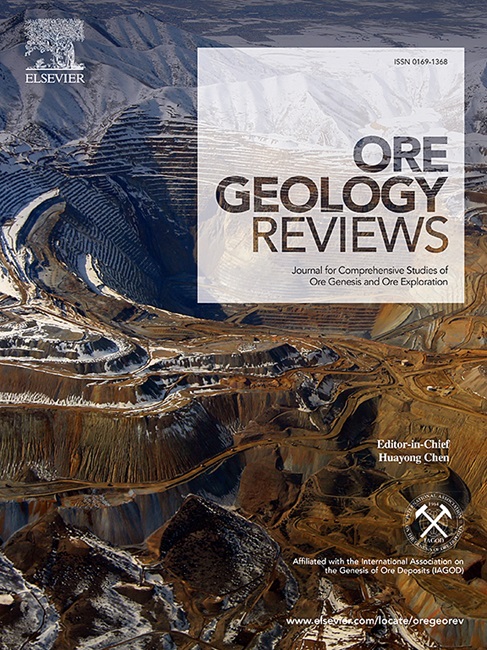Ore-forming process of the Saibagou gold deposit in the Northern Qaidam Orogen: Evidence from fluid inclusions, D-O isotopes and pyrite geochemistry
IF 3.2
2区 地球科学
Q1 GEOLOGY
引用次数: 0
Abstract
The northern Qaidam Orogen that hosts over 100 gold deposits is an important gold mineralization belt in Qinghai Province (western China). However, ore-forming processes and genesis of these gold deposits remain controversial. We analyzed the fluid inclusions (FIs), D-O isotopes and pyrite trace element compositions of the Saibagou gold deposit in the Tommorrit-Saibagou area and discussed the genesis of this deposit. These results show that the Saibagou gold ores contain three types of FIs: aqueous, aqueous-CO2, and pure CO2 type. The ore-forming fluids in each stage changed from an early medium temperature and low-salinity H2O-NaCl ± CO2 system to a late low-temperature and low-salinity H2O-NaCl system. The D-O isotopes show that the ore-forming fluids are the mixed fluids of metamorphic water and meteoric water. In the main-ore stage, the ore fluids are mainly metamorphic and minor magmatic water sourced, with increasing meteoric water incursion toward the late-ore stage. The Au and other ore-forming elements (such as Ag, Cu, Pb, Zn, Te) are positively correlated and are mainly enriched in pyrite in the stage II. We suggest that the Saibagou is an orogenic gold deposit and is closely related to the Late Silurian northward subduction and hyperplastic orogenesis in Qaidam Block.

柴达木造山带北缘赛八沟金矿床成矿过程:流体包裹体、D-O同位素和黄铁矿地球化学证据
柴达木北造山带是青海省重要的金矿成矿带,拥有100多个金矿床。然而,这些金矿床的成矿过程和成因仍存在争议。对东莫里特—西巴沟地区赛巴沟金矿流体包裹体、D-O同位素及黄铁矿微量元素组成进行了分析,探讨了该矿床的成因。结果表明,塞巴沟金矿矿石中含水型、水-CO2型和纯CO2型3种矿物矿物。各阶段成矿流体由早期的中温低盐度H2O-NaCl±CO2体系向晚期的低温低盐度H2O-NaCl体系转变。D-O同位素表明成矿流体为变质水和大气水的混合流体。在主矿期,矿石流体以变质流体为主,岩浆水来源较少,晚矿期大气水侵入增多。Au与其他成矿元素(Ag、Cu、Pb、Zn、Te)呈正相关关系,主要富集于II期黄铁矿中。认为塞巴沟是造山带型金矿床,与柴达木地块晚志留世北俯冲和增生造山作用密切相关。
本文章由计算机程序翻译,如有差异,请以英文原文为准。
求助全文
约1分钟内获得全文
求助全文
来源期刊

Ore Geology Reviews
地学-地质学
CiteScore
6.50
自引率
27.30%
发文量
546
审稿时长
22.9 weeks
期刊介绍:
Ore Geology Reviews aims to familiarize all earth scientists with recent advances in a number of interconnected disciplines related to the study of, and search for, ore deposits. The reviews range from brief to longer contributions, but the journal preferentially publishes manuscripts that fill the niche between the commonly shorter journal articles and the comprehensive book coverages, and thus has a special appeal to many authors and readers.
 求助内容:
求助内容: 应助结果提醒方式:
应助结果提醒方式:


